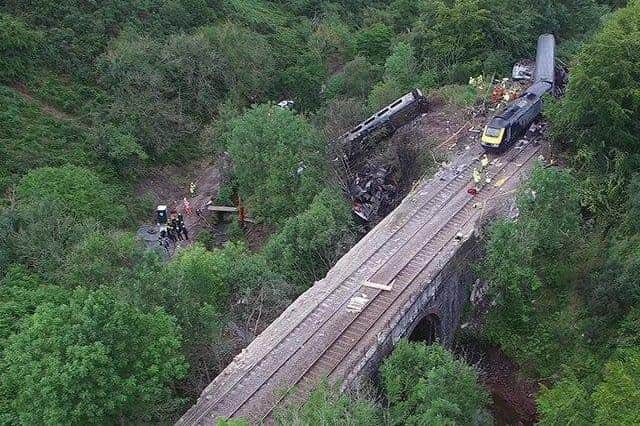Six drivers found to be breaking train speed restrictions on single day in Aberdeenshire in wake of Stonehaven crash
A 40mph (64 km/h) “blanket” emergency speed restriction (BESR) had been imposed temporarily between Laurencekirk and Portlethen in Aberdeenshire on December 4 last year due to heavy rain and the risk of damaged terrain obstructing the line.
Rail Accident Investigation Branch (RAIB) found six trains travelled up to 100mph (161km/h) on this day – the normal speed limit – despite the restriction being in place.
Advertisement
Hide AdAdvertisement
Hide Ad

Simon French, chief inspector of rail accidents, said he was concerned at the number of speeding incidents on the railway.
He said the investigation showed the industry’s methods to alert drivers to restrictions were “ineffective”.
The report said lineside signage was not used for BESRs and some drivers were unaware they were even in place.
A notice displayed where the drivers reported for duty was the only form of information about the temporary speed restriction, and it “did not convey information in a way that could be readily understood”, investigators said.
The railway line at the centre of the report is the same line that claimed the lives of three people when a 6:38am Aberdeen to Glasgow Queen Street train crashed into a landslide at Carmont, near Stonehaven, in August last year.
Driver Brett McCullough, 45, conductor Donald Dinnie, 58, and passenger Christopher Stuchbury, 62, died in the crash.
RAIB said the railway industry “has more work to do” to establish an improved method for imposing speed restrictions.
Mr French said: “RAIB is concerned at the number of over-speeding incidents which occur at speed restrictions on the mainline network.
Advertisement
Hide AdAdvertisement
Hide Ad“Network Rail’s national daily report has recorded seven cases so far in 2021, up from five in the whole of 2020, and some of these involved speed limits being exceeded by over 80 miles per hour.
The chief inspector said the latest report, released on Monday, showed how important it was to convey information to train drivers about emergency speed restrictions “in a way that they can understand”, particularly in an area where there are no lineside signs to mark where restrictions begin and end.
“As we saw in an incident at Sandy in 2018, it is possible for a driver who has not been given advance notice of a speed restriction to take their train through it much faster than is safe,” he said.
“Since then, the tragic accident at Carmont in 2020 has resulted in the introduction of a new process which Network Rail uses to impose speed restrictions over areas affected by severe weather, such as heavy rain, which might cause the failure of earthworks.
“The railway industry has more work to do to establish a suitable method for the imposition of speed restrictions which are needed in response to extreme weather that has the potential to endanger infrastructure.
“In this case the industry’s processes were ineffective, and it is fortunate that the weather was not as bad as feared and that no accident occurred.”
A final report into the Stonehaven crash was expected this autumn, but reports say it will not be published until January 2022.
Comments
Want to join the conversation? Please or to comment on this article.
